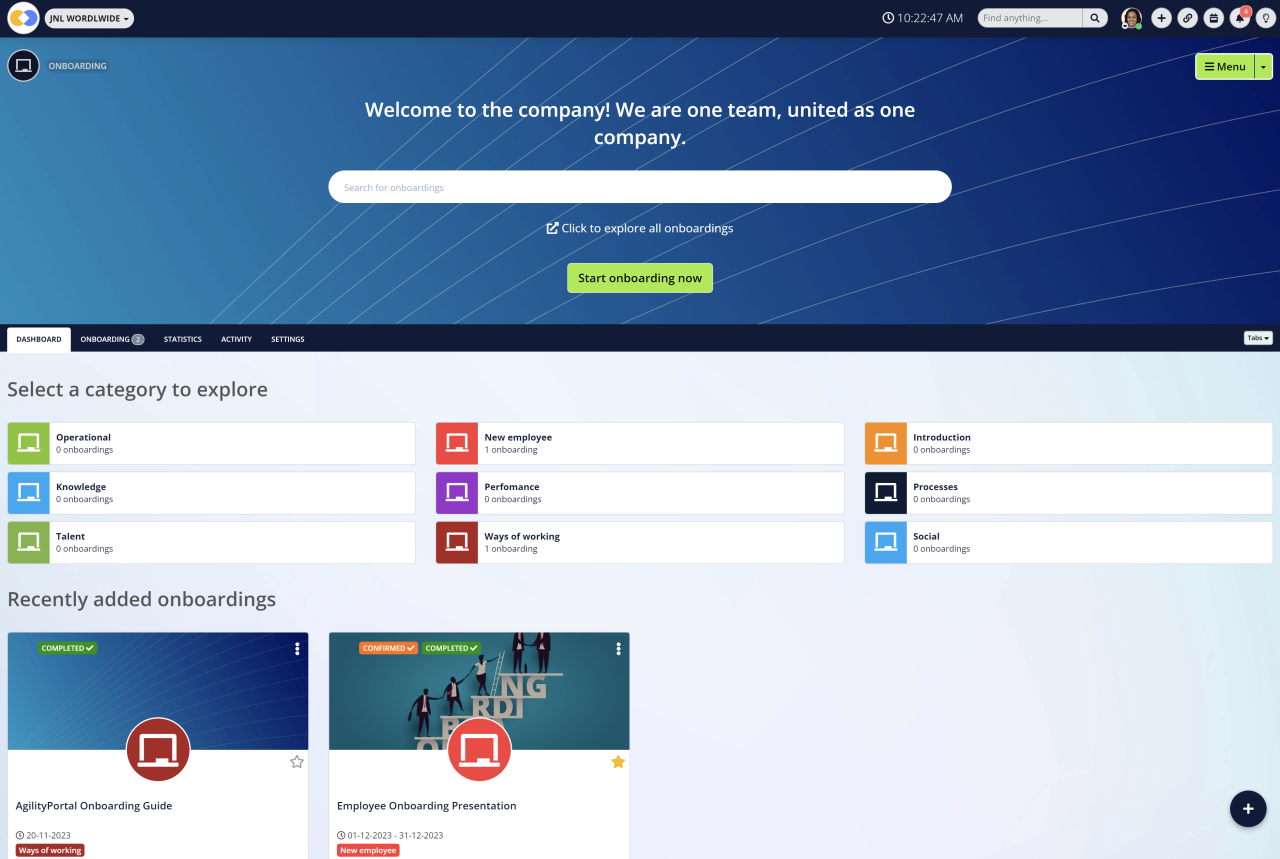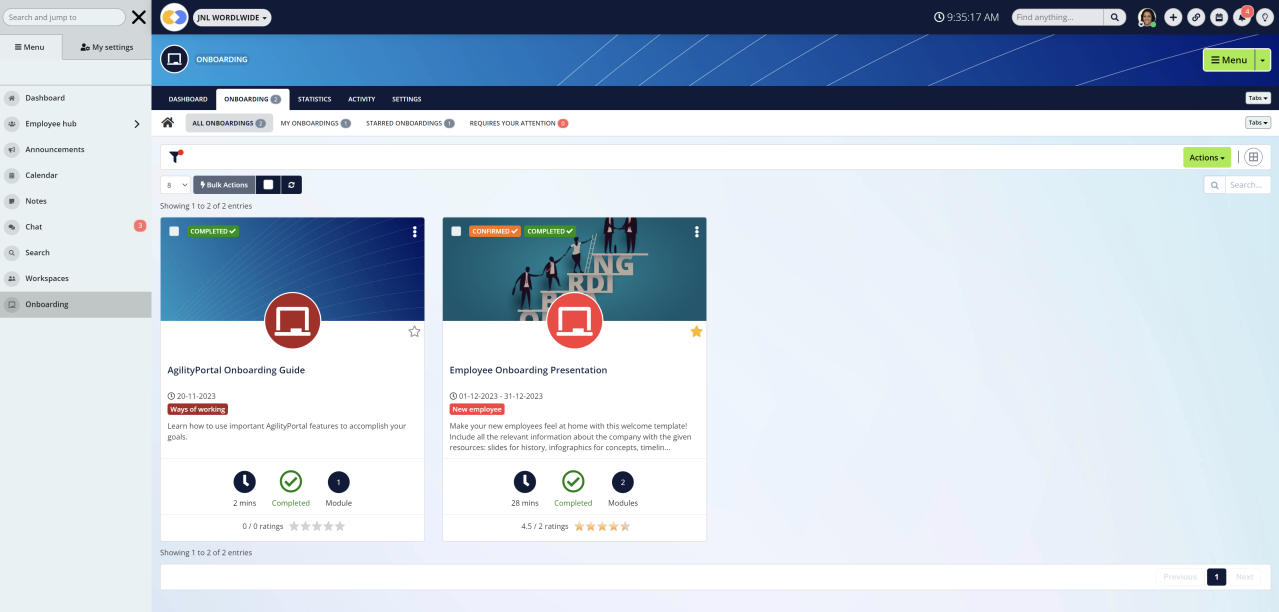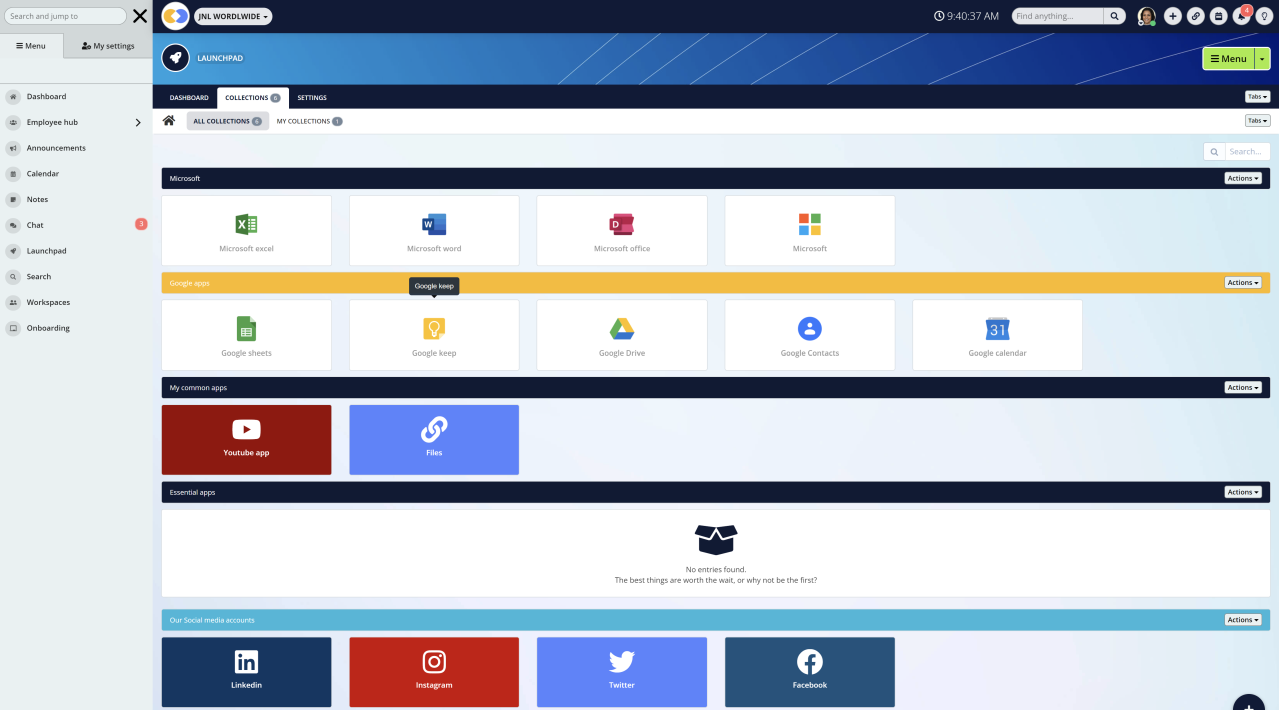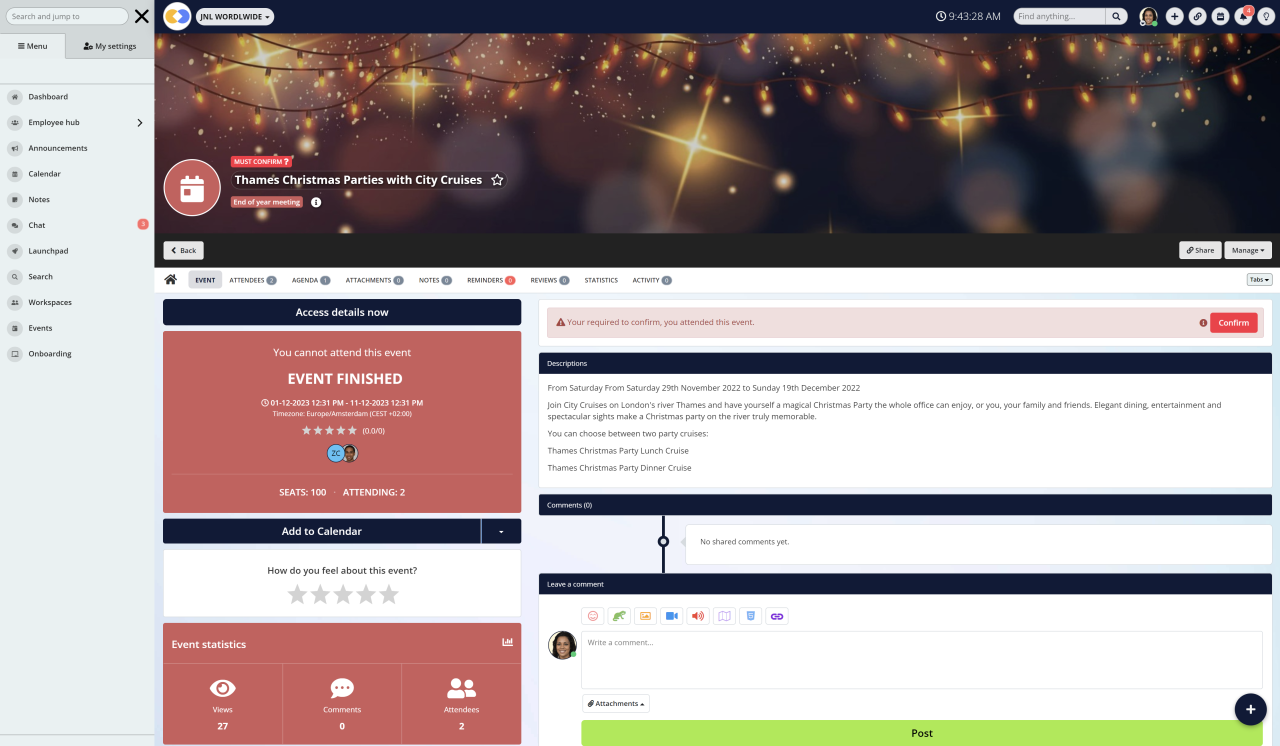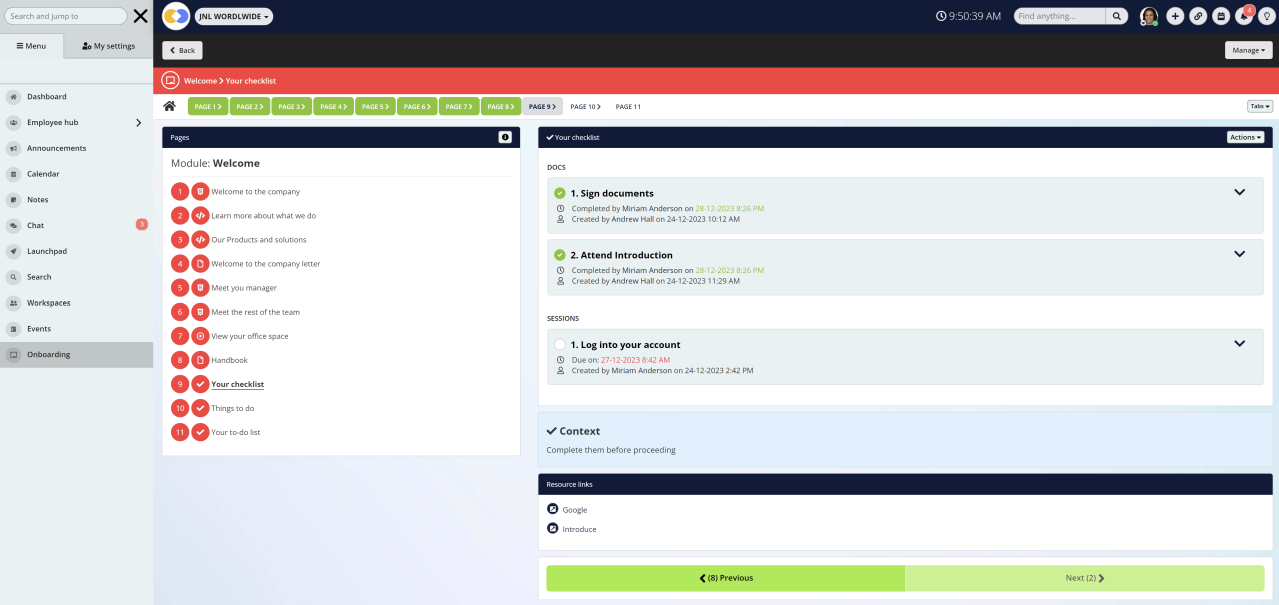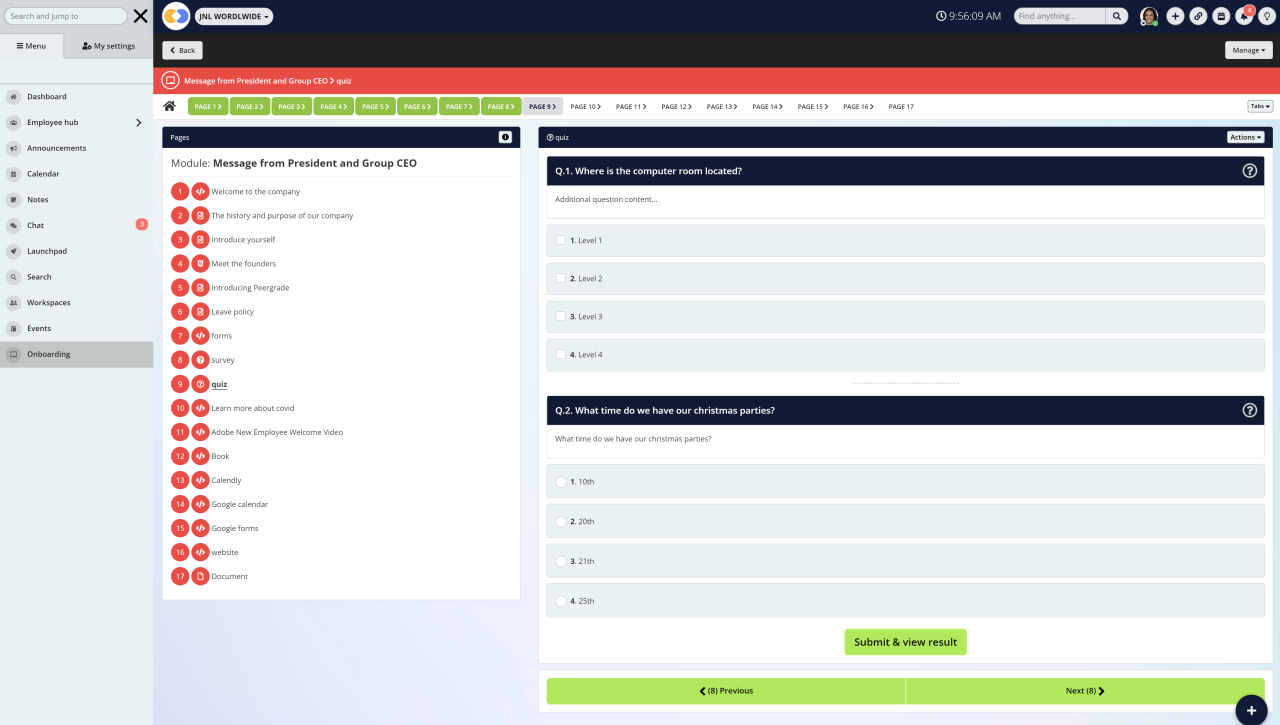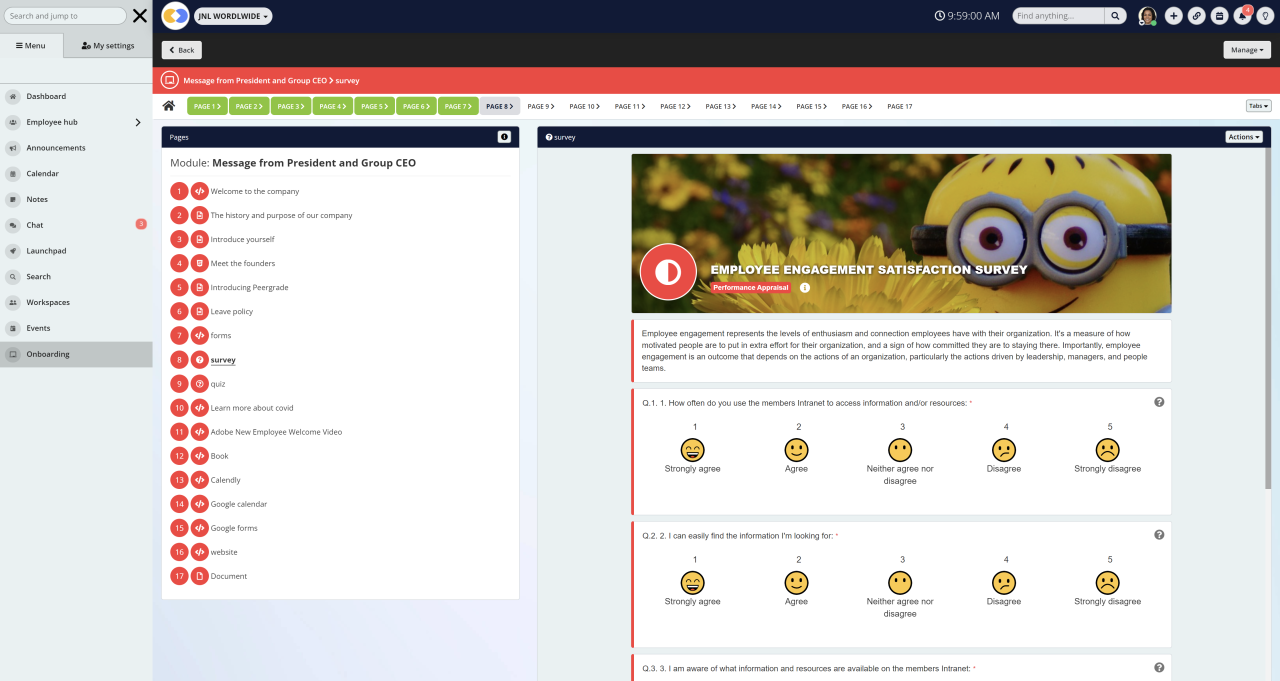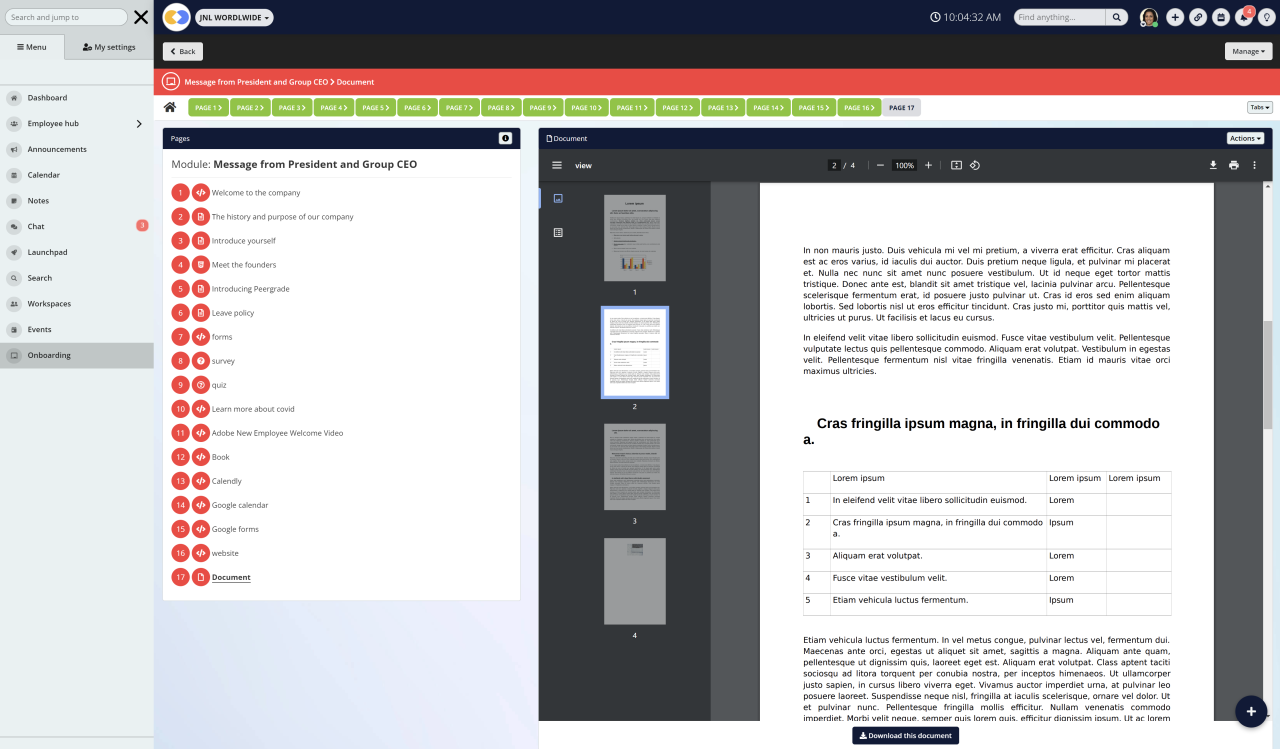Insight Blog
Agility’s perspectives on transforming the employee's experience throughout remote transformation using connected enterprise tools.
31 minutes reading time
(6118 words)
How to Onboard Employees So They Won’t Bounce in 2024
Employee onboarding is crucial to new-hire success. What are the biggest challenges and obstacles during the onboarding process, and how can managers and employees overcome them?
Onboarding is a critical journey during which new employees acquire the knowledge, skills, and behaviors necessary for seamless integration into an organization. It commences with administrative tasks, including paperwork and first-day orientation, typically managed by the HR department. Subsequently, role-specific training, such as shadowing a colleague and team integration, encompassing formal introductions and informal social interactions.
This phase of onboarding, typically overseen by the new employee's manager, facilitates relationship building, understanding of team dynamics, and a sense of belonging within the organization.
Assuming the responsibility of managing a new employee's onboarding process can be daunting, particularly if you are still navigating your own role. However, there are strategies you can employ to ensure that your new team members have a positive onboarding experience, setting the stage for their long-term success within your team.
Selecting an exceptional candidate requires a substantial investment of thousands of dollars and hundreds of staff hours. Honoring this investment and the individual must be honored by providing a considerate and effective onboarding experience. Explore these four key elements of a successful onboarding process to integrate into your organization seamlessly.
Understanding Employee Onboarding
Onboarding, often referred to in the human resources industry as organizational socialization, is the systematic process of introducing a newly hired employee to an organization. This crucial phase is vital in helping employees grasp the nuances of their new roles and job requirements, facilitating a seamless integration into the company.
The onboarding journey encompasses various activities, from the initial job offer to team training sessions. The duration of onboarding can vary significantly, ranging from a few weeks to a year. However, the most effective onboarding experiences typically extend over several months, aiming to instill confidence and competence in employees by the process's conclusion.
While there isn't a rigid rule dictating the duration of onboarding, thoroughness is key. Some companies opt for a brief onboarding process, lasting only a month or a few weeks. However, this approach risks overwhelming new employees with their responsibilities and impeding their ability to connect with the broader company culture.
Many HR professionals advocate for an onboarding process lasting approximately 90 days. Some even recommend extending this period up to a year.
This extended timeframe ensures that employees have the necessary resources to acquaint themselves with the company, internalize their training, and feel confident in fulfilling their job responsibilities as expected. A comprehensive and well-paced onboarding process sets the stage for long-term success and satisfaction for both the employee and the organization.
Importance of onboarding statistics: Understanding the importance of onboarding is underscored by compelling statistics highlighting its impact on employee engagement, productivity, and retention. According to studies, organizations with a well-structured onboarding process experience 50% greater productivity from new hires and achieve a 58% higher retention rate than those with inadequate onboarding practices.
Furthermore, 69% of employees are likelier to stay with a company for three years if they experience great onboarding.
These statistics emphasize how a thoughtful onboarding program contributes significantly to the long-term success and satisfaction of employees within an organization.
Onboard employees examples
Here are a few examples of how companies can onboard employees effectively:
- Welcome Package: Provide new employees with a welcome package containing company-branded items, an employee handbook, and a personalized welcome letter. This tangible gesture creates a positive first impression.
- Buddy System: Implement a buddy system where new hires are paired with experienced employees who can guide them through their first weeks, answer questions, and help them integrate into the team culture.
- Orientation Sessions: Conduct comprehensive orientation sessions that cover the company's history, mission, values, and organizational structure. Include an introduction to key team members and an overview of departmental functions.
- Digital Onboarding Platforms: Utilize digital onboarding platforms like AgilityPortal to automate administrative tasks, manage paperwork, and guide new hires through the onboarding process efficiently.
- Training and Development Programs: Offer training programs tailored to the specific roles of new employees. This ensures they acquire the necessary skills and knowledge to excel in their positions.
- Regular Check-ins: Schedule regular check-ins with new hires during their first few weeks to address any concerns, gather feedback, and ensure they are comfortable with their roles and responsibilities.
- Company Culture Initiatives: Introduce new employees to the company culture through team-building activities, social events, or virtual meetups. This helps them feel connected and engaged with their colleagues.
- Technology Orientation: Provide a technology orientation session to familiarize new hires with the tools and software used within the company. This ensures they can navigate digital platforms seamlessly.
- Clear Expectations: Set clear expectations regarding job roles, performance metrics, and career growth opportunities. This transparency helps new employees understand their responsibilities and align their goals with the company's objectives.
- Feedback Mechanism: Establish a feedback mechanism where new hires can share their onboarding experiences, suggest improvements, and express any challenges they may be facing. This input can be valuable for refining the onboarding process.
These examples showcase a mix of traditional and modern onboarding practices, emphasizing the importance of creating a welcoming and structured experience for new employees
What Are Onboarding Activities?
Onboarding comprises a series of distinct processes, and despite its integral role in welcoming new employees, there is no universally accepted definition. Opinions continue to diverge regarding the specific activities encompassed by the term "onboarding."
Among the myriad onboarding activities, several common elements play a crucial role in the comprehensive onboarding experience. These include:
- Job Offers: The initiation of onboarding often commences with the formal presentation of a job offer, signaling the official beginning of the employee's journey with the organization. This phase establishes the foundation for the ensuing onboarding processes.
- Salary Negotiation: Salary negotiations, integral to the onboarding process, reflect the mutual alignment of expectations between the employee and the organization. Clear and transparent discussions during this phase contribute to a positive and satisfactory onboarding experience.
- New Hire Paperwork: Completing new hire paperwork is a fundamental aspect of onboarding, involving the formal documentation required for employment. This includes personal details, tax-related information, and other essential documents necessary for HR and organizational compliance.
- Policy and Culture Training: Immersing new hires in the company's policies and culture is a pivotal onboarding step. This training not only imparts knowledge about the organization's values and principles but also fosters a sense of alignment and belonging among new team members.
- Job Training: Job-specific training ensures that new employees acquire the skills and knowledge essential for their roles. This targeted training phase contributes to the employee's successful integration into their designated responsibilities.
- Employee Handbook Training: Familiarizing new hires with the employee handbook is a crucial onboarding component. This document serves as a comprehensive guide detailing company policies, expectations, and essential information that aids in navigating the organizational landscape.
- Benefits Paperwork: Onboarding often involves the completion of benefits-related paperwork, ensuring that employees are enrolled in the organization's health, retirement, and other relevant benefit programs.
- Benefits Education: Beyond paperwork, educating new hires about the available benefits, including healthcare plans, retirement options, and other perks, enhances their understanding of the comprehensive package offered by the organization.
- Facility Tours: Guiding new employees through the physical workspace via facility tours provides them with a tangible understanding of their work environment. This fosters a sense of orientation and familiarity, contributing to a smoother integration process.
- Executive Introductions: Introducing new hires to executive leadership creates a sense of connection and demonstrates the organization's commitment to a welcoming and inclusive culture. These interactions may include meet-and-greet sessions or formal introductions, fostering a positive relationship from the outset.
- Team Introduction: Facilitating introductions to the immediate team is a cornerstone of onboarding. Building relationships with colleagues and understanding team dynamics contribute significantly to the new employee's sense of belonging within the organization.
So remember that onboarding encompasses a multifaceted array of activities, each uniquely acclimating new employees to their roles, the company culture, and the broader organizational landscape. A comprehensive and well-executed onboarding process sets the stage for a positive and productive employee experience.
The Employee Onboarding Process: How to Onboard Employees
Effective employee onboarding is a critical component of a successful talent management strategy. It goes beyond just introducing new hires to their roles; it encompasses a holistic approach to integrate them into the organizational culture, clarify their roles, and establish a foundation for long-term success. Here's a detailed breakdown of the key elements in the employee onboarding process.
1.Provide Information on Company Policies and Benefits
One of the initial steps in onboarding is to equip new employees with essential information regarding company policies and benefits. This includes a comprehensive overview of HR policies, codes of conduct, and an explanation of the benefits package. Clear communication about these aspects sets the groundwork for employees to understand their rights, responsibilities, and the support available to them within the organization
2.Provide Role Clarity
Ensuring role clarity is paramount for the success of new hires. During onboarding, organizations should provide detailed insights into the expectations and responsibilities associated with each role. This involves sharing job descriptions, key performance indicators (KPIs), and performance expectations. Clarity in roles not only enhances productivity but also contributes to employee satisfaction and engagement.
3.Facilitate Training
Training is a crucial component of the onboarding process. It involves both general training on company policies and specific job-related training. General training may cover topics like cybersecurity, workplace safety, and diversity and inclusion. Job-related training, on the other hand, is tailored to the specific skills and knowledge required for the new role. A well-structured training program accelerates the integration of new hires into their positions.
4.Induct into Organizational Culture
Organizational culture plays a pivotal role in shaping the work environment. During onboarding, it is essential to immerse new employees into the company's culture. This can be achieved through orientation sessions, introducing core values, and sharing anecdotes that exemplify the organization's ethos. A strong cultural fit contributes to employee satisfaction, reduces turnover, and fosters a positive workplace atmosphere.
5.Help Form Social Connections with Colleagues
Building social connections is a key aspect of onboarding that is often overlooked.
Encouraging new hires to form relationships with their colleagues promotes a sense of belonging and team cohesion. Activities such as team lunches, informal gatherings, or mentorship programs can facilitate social connections. A supportive social network within the workplace contributes to a positive employee experience and helps in the retention of talent.
A well-executed employee onboarding process is a strategic investment that pays off in terms of increased productivity, higher employee satisfaction, and improved retention rates. By addressing these key elements - providing information on company policies, ensuring role clarity, facilitating training, inducting into organizational culture, and promoting social connections - organizations can create a positive and impactful onboarding experience for their new hires.
Why is onboarding important for retention 2024
An inadequate onboarding experience can leave employees uneasy, perplexed, and demoralized.
According to a recent survey by Paychex, 52% of new hires express a sense of being undertrained post-onboarding, with small company employees (66%) and remote workers (63%) facing the greatest challenges. This deficiency significantly impacts productivity and retention. Another report reveals that 51% of employees would go "above and beyond" in their work if they had a positive onboarding experience. Conversely, a subpar onboarding experience can decrease employee engagement, costing businesses 18% of their employees' salaries.
The consequences of a poor onboarding experience extend to high turnover rates, with a staggering 50% of newly hired employees planning to leave their jobs soon, skyrocketing to 80% for those who feel undertrained due to inadequate onboarding. In contrast, 7% of well-trained employees are inclined to leave soon.
Despite the compelling evidence emphasizing the significance of effective onboarding, many managers and organizations struggle to get it right. A recent survey indicates that only 52% of new hires feel satisfied with their onboarding experience, with 32% finding it confusing and 22% deeming it disorganized. Remote workers face even greater challenges, with 36% finding the onboarding process baffling.
It is crucial for first-time managers to address these onboarding gaps to retain their team members and sustain overall productivity.
So, in a nutshell, Why is onboarding important for retention? It's crucial for employee retention as it sets the foundation for a positive work experience, fostering a sense of belonging and engagement from the beginning.
Understand Onboarding Challenges
Are you familiar with the saying, "The first impression is the best impression"?
Onboarding serves as the definitive first impression. It establishes the atmosphere for your new hire's entire career, influencing whether they become a positive brand ambassador or contribute to a negative Glassdoor review.
While not everything is entirely avoidable, you can be proactive.
Explore these typical issues that often hinder onboarding and hurt the overall employee experience.
Lack of Role Clarity
When new employees lack clear guidance on their roles and responsibilities, it creates a sense of uncertainty. They may struggle to understand their specific duties and expectations and how their contributions align with the broader goals of the organization. This ambiguity can lead to frustration and hinder their ability to engage in their work proactively.
Too Much Information Overload
Providing an overwhelming amount of information during the onboarding process can be counterproductive. New hires may find it challenging to absorb and prioritize the vast array of data, leading to confusion and potential cognitive overload. This, in turn, can impede their ability to apply the information effectively in their daily tasks.
Issues With Onboarding Content Access
Seamless access to onboarding materials is essential for effective learning. Difficulties in accessing content, whether due to technical issues or a lack of centralized information, can hinder new employees' progress. Limited access may result in delays in understanding crucial processes, policies, and expectations, slowing down their integration into the organizational ecosystem.
Old Outdated Manual Onboarding Processes
Relying on manual onboarding processes, such as extensive paperwork and administrative tasks, can be time-consuming and error-prone. This traditional approach not only consumes valuable resources but also introduces the risk of inaccuracies. Automating and streamlining onboarding procedures can enhance efficiency, reduce errors, and contribute to a more positive onboarding experience.
Tech Knowledge Gap
In today's tech-driven workplaces, a knowledge gap in essential tools and platforms can be a significant hurdle. If new employees lack proficiency in the digital tools integral to their roles, it can impede their ability to collaborate, communicate, and execute tasks efficiently. Bridging this tech knowledge gap through targeted training and support is crucial for ensuring a smooth transition into the digital work environment.
Improve Existing Onboarding Process
If your recent transition to a remote work environment has taken place, it's essential to revisit job descriptions and handbooks to incorporate remote work policies. This includes introducing more flexible schedules wherever feasible.
A remote onboarding plan necessitates a distinct set of priorities compared to the original plan, which was likely tailored for a traditional office setting.
If you haven't done so already, it's time to revamp your employee handbook to make it more digitally friendly.
Consider:
- Consolidating crucial policies into one PDF package alongside important forms or links for taxes and benefits.
- Utilizing hyperlinks for easy reference to regulations and resources.
- Incorporating multimedia to disseminate information effectively.
- Exploring dedicated employee handbook software for a more streamlined approach.
Onboarding a new remote team member provides an excellent opportunity to assess current onboarding processes and make necessary adjustments.
Consider the following:
- What does your existing employee onboarding plan include?
- How effective is your current onboarding process?
- What aspects have other employees found helpful or not useful?
- What elements are lacking in the traditional methods of helping employees acclimate?
- Has the shift to remote work influenced your workplace culture?
- What practices contribute to making all employees feel genuinely valued?
Factor In New Employee's Remote Work Style During the Onboarding Process
- Productivity and Overworking: Striking the right balance between productivity and preventing burnout can be challenging in a remote work setup. The absence of clear boundaries between work and personal life may lead to individuals overworking, impacting their overall well-being.
- Lack of Camaraderie: The sense of camaraderie that naturally develops in a physical office environment can be challenging to replicate remotely. The absence of casual interactions and spontaneous discussions may affect team cohesion and employee morale.
- Clear Communication of Policies and Procedures: Remote work requires effective communication of company policies and procedures. Ensuring that all team members have a comprehensive understanding of expectations, guidelines, and changes becomes crucial to maintaining a cohesive and compliant work environment.
- Managing HR Paperwork: Remote work often involves dealing with HR paperwork electronically. Establishing efficient systems for document submission, verification, and record-keeping is vital to streamline HR processes and maintain compliance.
- Video Conferencing Challenges, Including Fatigue: While video conferencing facilitates virtual collaboration, prolonged use can lead to fatigue. Recognizing the need for breaks, alternative communication channels, and strategies to combat virtual meeting exhaustion is essential.
- Lack of Motivation to Interact for New Employees: New employees, especially in a remote setting, may face challenges initiating conversations and building connections. Implementing structured onboarding programs that encourage interaction and mentorship can help integrate new team members.
- Poor Training Tools and Structure:Inadequate training tools and a lack of structured onboarding programs can hinder the seamless integration of new employees into the remote work environment. Providing comprehensive training resources and mentorship opportunities is vital for their success.
- Unavailability of Management:The physical distance in remote work may lead to a perception of management unavailability. Establishing clear channels for communication, regular check-ins, and accessible management can address this challenge.
- Lack of Immediate, Face-to-Face Connection:The absence of face-to-face interactions may result in a perceived lack of immediacy in addressing concerns or seeking feedback. Utilizing virtual platforms effectively and fostering open communication channels becomes crucial.
- Lack of Nonverbal Cues in Conversations:Remote communication lacks the richness of nonverbal cues present in face-to-face interactions. Encouraging the use of video calls and adopting clear communication practices can help bridge this gap.
- Lack of Scheduling Flexibility: While remote work is often associated with flexibility, some employees may face challenges in balancing work hours. Discussing and accommodating varying schedule preferences during onboarding can contribute to a healthier work-life balance.
So recognizing and actively addressing these challenges is crucial for fostering a positive remote work environment. Managers play a pivotal role in understanding individual work styles, promoting effective communication, and implementing strategies that enhance the overall remote work experience.
Follow us and access great exclusive content everyday: Follow us on Google News
New Hire Onboarding Checklist
Every thriving company recognizes that the cornerstone of a seamless recruitment process lies in the effectiveness of its onboarding procedures.
The more meticulous the onboarding process, the smoother the assimilation of new hires into their roles, enabling them to gain a comprehensive understanding of job expectations and fostering a sense of camaraderie within the team.
A robust onboarding process not only benefits the employees but also serves the employer by ensuring enhanced job performance, increased operational efficiency, and a higher level of employee satisfaction, thereby boosting engagement and retention rates. In essence, a well-structured onboarding plan aligns the interests of all stakeholders involved.
Given the multifaceted nature of preparing a new hire for success, an onboarding checklist proves invaluable in ensuring that no essential elements are overlooked, especially during the hectic initial weeks.
Here are key considerations to incorporate into your onboarding process checklist template:
- Clear Job Expectations: Clearly communicate job responsibilities and expectations to provide new hires with a solid foundation for their role.
- Team Integration: Facilitate activities or introductions that foster a sense of belonging and connection with the team, enhancing the new hire's integration into the company culture.
- Training and Skill Development: Implement comprehensive training programs that equip new hires with the necessary skills and knowledge for their specific roles.
- Company Policies and Culture: Educate new employees on company policies, values, and culture, ensuring alignment with the organizational ethos.
- Performance Expectations: Clearly outline performance expectations and key performance indicators to guide new hires toward achieving success in their roles.
- Feedback Mechanism: Establish a feedback mechanism to encourage open communication and provide constructive feedback during the initial phases of employment.
- Mentorship Opportunities: Provide mentorship opportunities to facilitate the integration process and offer guidance from experienced team members.
- Resource Access: Ensure new hires have access to essential resources, tools, and information required for their daily tasks.
- Introduction to Company Tools and Systems: Familiarize new employees with the various tools, software, and systems essential for their roles to enhance efficiency.
- Performance Review Schedule: Outline a schedule for performance reviews to provide ongoing support, address concerns, and celebrate achievements.
Try by incorporating these elements into your onboarding checklist, you can create a comprehensive and systematic onboarding process that maximizes the success and satisfaction of new hires while contributing to the overall success of the organization.
Elements of an Effective Employee Onboarding Workflow
An employee onboarding workflow serves as a structured series of predetermined steps designed to introduce a new employee to the organizational environment and culture. A well-crafted and seamless onboarding process is paramount for organizations seeking to establish early engagement with their employees and provide a positive and streamlined onboarding experience.The onboarding journey encompasses a spectrum of activities, including new hire orientation, training modules, socialization initiatives, and more.
Key Elements of an Effective Employee Onboarding Workflow:
- New Hire Orientation:The onboarding workflow typically kicks off with a comprehensive new hire orientation. This session introduces the employee to the organization's mission, values, and overarching goals, fostering an early understanding of the company's ethos.
- Training Programs:An integral component involves the implementation of targeted training programs. These sessions equip new employees with the skills, knowledge, and tools essential for their roles, ensuring a smooth transition into their responsibilities.
- Socialization Initiatives:Beyond formal training, socialization initiatives are crucial for integrating new hires into the company culture. These activities may include team-building exercises, introductions to colleagues, and opportunities for informal interactions.
- Introduction to Policies and Procedures:Providing a detailed overview of organizational policies and procedures is essential. This step ensures that new employees are well-versed in the guidelines governing their conduct and performance within the company.
- Technology Onboarding:Familiarizing new hires with the various technological tools and systems used within the organization is vital. This facilitates a smooth adaptation to the digital landscape of the workplace.
- Mentorship Opportunities:Incorporating mentorship programs into the workflow offers new employees a supportive relationship with experienced colleagues. This mentorship aids in navigating the organizational landscape and provides a valuable resource for questions and guidance.
- Feedback Mechanism:Establishing an open and accessible feedback mechanism is key. This allows new hires to express concerns, seek clarification, and receive constructive feedback during the early stages of their employment.
- Performance Expectations:Clearly articulating performance expectations and key performance indicators (KPIs) helps set a benchmark for success. This step guides new hires in aligning their efforts with the organization's objectives.
- Resource Access:Ensuring that new employees have seamless access to essential resources, whether physical or digital, is crucial for uninterrupted workflow and productivity.
- Ongoing Support:The onboarding workflow should not be perceived as a one-time event but rather as an ongoing process. Providing continuous support, check-ins, and opportunities for further skill development contribute to sustained employee growth and engagement.
In essence, a meticulously designed employee onboarding workflow not only imparts knowledge but also cultivates a sense of belonging and purpose within the organizational framework. By incorporating these elements, organizations can optimize their onboarding processes, setting the stage for a successful and enduring employer-employee relationship.
You may also like: Best Apps for Employees: UPDATED 2022 – A Complete Guide
Benefits of using an employee onboarding automation
Establishing a robust employee onboarding process is crucial to mitigate last-minute confusions and ensure compliance with regulatory requirements. An efficient employee onboarding software plays a pivotal role in streamlining this process, offering a range of benefits that contribute to a seamless and effective onboarding experience.
Key Advantages of an Efficient Employee Onboarding Software:
- Clearly Outlined Onboarding Template: An effective onboarding software provides a clearly outlined template, offering a structured framework for the onboarding process. This ensures that essential steps are systematically followed, minimizing oversights.
- Minimization of Paperwork Chaos: By digitizing onboarding documents and processes, the software minimizes the chaos associated with traditional paperwork. This not only enhances efficiency but also contributes to a more environmentally friendly and sustainable onboarding approach.
- Shortened Onboarding Lifecycle: The software is designed to expedite the onboarding lifecycle, reducing the time it takes for new hires to transition from recruitment to fully functional team members. This accelerated process enables organizations to capitalize on employee productivity sooner.
- Reduction of Manual Intervention and Human Errors: Automated onboarding processes significantly reduce manual intervention, minimizing the likelihood of human errors. This ensures accuracy in data entry, compliance adherence, and overall process efficiency.
- Lessened Workload for the HR Team: By automating repetitive tasks and simplifying administrative processes, onboarding software lessens the workload for the HR team. This allows HR professionals to focus on more strategic aspects of talent management and employee engagement.
- Consistent Experience for All New Hires: The software ensures a consistent onboarding experience for all new hires, irrespective of individual differences. This consistency contributes to a cohesive organizational culture and helps in delivering standardized information and training.
- Transparency in Process Flow: Injecting transparency into the onboarding process flow is a key feature of the software. This transparency allows both employees and HR personnel to track the progress of onboarding tasks, fostering accountability and clear communication.
- Memorable Onboarding Experience for Employees: By providing a seamless, efficient, and well-organized onboarding journey, the software contributes to a memorable experience for new hires. A positive onboarding experience sets the tone for employee satisfaction and long-term engagement.
Guidelines for Effective Onboarding Solutions:
To implement an effective onboarding solution, consider the following:
- Assess Your Organizational Needs: Identify specific onboarding challenges and requirements unique to your organization to tailor the software to meet these needs.
- User-Friendly Interface: Choose software with an intuitive and user-friendly interface to facilitate easy navigation and usage for both HR professionals and new hires.
- Customization Options: Opt for a solution that offers customization options, allowing you to adapt the onboarding process to align with your organizational structure and policies.
- Integration Capabilities: Ensure that the onboarding software seamlessly integrates with other HR and organizational systems, promoting a cohesive and interconnected approach to talent management.
- Security Measures: Prioritize the security of sensitive employee data by selecting onboarding software that incorporates robust security measures and compliance protocols.
By leveraging an efficient employee onboarding software and following these guidelines, organizations can transform their onboarding processes into a strategic asset that enhances efficiency, promotes compliance, and cultivates a positive and memorable experience for new hires.
Automate your onboarding with AgilityPortal
While automation is not a novel concept, AgilityPortal takes it a step further by offering the capability to automate employee onboarding. Although we are familiar with automated reminders and chatbots, creating an intuitive onboarding experience requires more. It necessitates engaging with your workforce to identify missing elements, areas for improvement, and opportunities for simplification to deliver a comprehensive onboarding experience.
AgilityPortal's employee onboarding software is tailored to meet your onboarding objectives. Whether you choose to create your templates swiftly or opt for our carefully curated selection, these templates are user-friendly, customizable, and empower you to provide prompt resolutions to your employees without compromising a positive experience.
AgilityPortal's employee onboarding software offers a sophisticated automation solution that goes beyond the ordinary, emphasizing user engagement and customization to deliver a comprehensive onboarding experience for both employers and employees.
Free ebook: How To Get Your Intranet Off The Ground
1. Simplify your preboarding workflows
The pre-boarding phase initiates a few days or weeks before the new candidate commences their role.
Upon the candidate's acceptance of the job offer, our platform facilitates the automation of the employee onboarding process, streamlining various actions such as:
- IT Account Creation Notification: Automatically notifying the IT department to generate user accounts for the new employee.
- Welcome Email Dispatch: Utilizing our platform to automate the sending of a welcome email that elucidates company perks, culture, and policies. Crafting these welcome emails is effortlessly accomplished using our free email template creator.
- Welcome Package Dispatch Notification: Promptly notifying designated personnel to dispatch a welcome package to the new employee.
- Calendar Blocking Coordination: Efficiently preparing teammates by coordinating the blocking of their calendars in anticipation of the new team member's arrival.
- Preboarding Process Tracking: Utilizing the platform to track the progress of the pre-boarding process, ensuring a seamless transition to the subsequent onboarding stage.
This streamlined and automated approach to pre-boarding and onboarding enhances efficiency, reduces manual interventions, and contributes to a positive and organized experience for both the employee and the organization.
2. Instantly integrate apps
Communication platforms such as Slack, Teams, and Notion have revolutionized remote work by enabling seamless connectivity regardless of geographical locations. Enhance and streamline your communication processes by effortlessly linking individuals, fostering collaboration, and promoting a cohesive work environment.
When integrating apps like Microsoft Teams or Slack, the onboarding process becomes more efficient and engaging.
Through this integration, you can:
- Automate Onboarding via Slack: Automatically add new hires to dedicated onboarding channels, creating a centralized space for relevant discussions and information.
- Facilitate Healthy Conversations: Encourage meaningful conversations among new hires within the integrated platform, promoting a collaborative and inclusive onboarding experience.
- Send Gradual Information, Tasks, and Reminders: Seamlessly deliver essential information, tasks, and reminders to new hires in a structured and gradual manner, ensuring a smooth onboarding progression.
- Connect New Hires with Onboarding Buddies: Utilize Slack or Teams to connect new hires with their onboarding buddies, fostering mentorship and collaboration. Notifications can be sent to both parties to facilitate the connection.
- Schedule Orientation/Onboarding Meetings: Easily schedule and manage orientation and onboarding meetings within the integrated communication platform, ensuring effective communication and coordination.
On the flip side, consider the wealth of existing content within your organization, including company videos and documents. Leveraging these resources can enhance the onboarding experience significantly.
By seamlessly integrating communication platforms and utilizing existing content, organizations can create a collaborative and efficient onboarding process that transcends physical boundaries, fostering a connected and engaged remote workforce.
3. Integrate new hires faster with regular events
Alleviate the initial anxieties of your new hires by dedicating quality time to share a meal or coffee, either in person or virtually through platforms like Microsoft Teams or Zoom.
Facilitate spontaneous connections among colleagues by organizing casual meetups or walking meetings, providing an opportunity to build stronger workplace relationships and offering a refreshing break from screen-based interactions. These sessions foster meaningful conversations, contributing to enhanced team spirit, increased productivity, and improved mental well-being.
4. Setup checklist to keep employees on track
New employee onboarding checklist is a great way to keep new employees on track. Leveraging the AgilityPortal Setup Checklist is a strategic approach to keeping employees on track during the onboarding process.
This comprehensive checklist serves as a structured guide, ensuring that all essential tasks and requirements are systematically addressed.
From IT account setups to the dispatch of welcome emails and coordination of orientation meetings, the AgilityPortal Setup Checklist streamlines the onboarding journey. Its user-friendly interface facilitates easy navigation for both HR professionals and new hires, enhancing the efficiency and effectiveness of the onboarding process.
By employing this checklist, organizations can maintain a well-organized onboarding experience, fostering a positive introduction for employees and setting the stage for long-term success within the company.
5.Add quizzes for engagement
Incorporating quizzes into the onboarding process through the AgilityPortal Setup Checklist is a proactive measure to enhance employee engagement.
This feature adds an interactive element to the onboarding journey, allowing new hires to test their understanding of key information and concepts.
By integrating quizzes, organizations not only ensure that employees grasp crucial details but also make the onboarding experience more engaging and participatory.
This interactive approach not only reinforces learning but also encourages employees to actively participate in their onboarding, fostering a sense of involvement and contributing to a more memorable and impactful onboarding experience.
6.Get Feedback with Surveys
Integrating surveys into the onboarding process using the AgilityPortal Setup Checklist is a valuable strategy to gather feedback and enhance the overall onboarding experience.
By including surveys at key checkpoints, organizations can systematically collect insights from new hires regarding their onboarding journey.
These surveys provide a platform for employees to share their perspectives on the effectiveness of the onboarding process, identify areas for improvement, and express their overall satisfaction. The feedback obtained through surveys becomes a valuable resource for HR teams to continually refine and optimize the onboarding process, ensuring that it aligns with the evolving needs and expectations of new hires.
This iterative feedback loop promotes a culture of continuous improvement and responsiveness, contributing to a more tailored and successful onboarding experience for future employees.
7.Embed employee handbook and documents
The ability to embed documents directly into the onboarding process is a valuable feature of AgilityPortal.
This centralizes document management, making essential materials easily accessible in one location. New hires benefit from streamlined access to important documents, reducing the need for separate distribution and enhancing the overall user experience.
Embedding documents within the onboarding process contributes to compliance and record-keeping. It ensures that new hires review and acknowledge critical policies, agreements, and regulatory documents. This feature also facilitates easy record-keeping, supporting organizations in meeting compliance requirements and providing an audit trail.
Beyond operational benefits, embedding documents in the onboarding process has positive environmental implications. This approach reduces the reliance on traditional paperwork, aligning with modern practices that promote a paperless work environment and contribute to sustainability.
The benefits of AgilityPortal's Onboarding Module extend to time and cost savings for HR teams. By automating tasks and centralizing document management, the platform streamlines processes that would traditionally be time-consuming and resource-intensive.
Does automation take away human interaction?
Contrary to common misconceptions, automation does not lead to isolation from human interactions; instead, it creates additional opportunities for people to connect and foster relationships. When you choose to automate your onboarding process, routine tasks and inquiries are efficiently handled, regardless of whether employees work in a hybrid or remote setup.
As an HR manager in a growing organization, the repetitive onboarding tasks, such as documentation, reminders, and addressing common questions, can quickly become overwhelming. The pursuit of time-saving measures can inadvertently introduce inconsistencies, impacting the overall experience for new employees.
By opting for automation through AgilityPortal, the onboarding process becomes more streamlined, allowing new employees to be significantly more productive in their initial weeks. With less time spent on administrative tasks like paperwork, they can devote more time to meaningful interactions, whether it's meeting colleagues over coffee, exploring the office during tours, or engaging in valuable discussions between meetings.
Wrapping up
Inadequate onboarding processes can translate to heightened turnover rates. While the challenges mentioned earlier may seem formidable, they are not insurmountable.
The key lies in making a commitment to your hires, as their commitment to your organization follows suit. According to McKinsey, the productivity of new hires steadily increases with each year they spend in their roles. However, to retain these new employees as valuable assets, the initial focus should be on building them up.
It's acknowledged that certain challenges may arise unexpectedly and cannot always be predicted or prevented. Nevertheless, the crucial factor is the effort invested in establishing a sustainable onboarding program, incorporating feedback, and empowering new employees.
To create a sustainable program, reliance on two essential elements is paramount:
- Communication: Effective communication signals to new hires that the organization is dedicated to their success. Personal interactions are vital, but time constraints necessitate leveraging available tools.
- Automation: Automation, such as the capabilities offered by AgilityPortal, significantly reduces time spent on documentation. Visual documents created through tools like AgilityPortal underscore the organization's serious commitment to the success of new hires. These documents are not only easy to create but also to update, store, and share, ensuring a personalized onboarding experience for each individual.
In conclusion, the aim is to build a more robust onboarding program by taking advantage of tools like AgilityPortal. Start your journey toward improvement today by accessing AgilityPortal for a free 14-day trial.
Categories
Blog
(2624)
Business Management
(320)
Employee Engagement
(211)
Digital Transformation
(175)
Intranets
(120)
Growth
(119)
Remote Work
(61)
Sales
(48)
Collaboration
(37)
Culture
(29)
Project management
(29)
Customer Experience
(26)
Knowledge Management
(21)
Leadership
(20)
Comparisons
(6)
News
(1)
Ready to learn more? 👍
One platform to optimize, manage and track all of your teams. Your new digital workplace is a click away. 🚀
Free for 14 days, no credit card required.





